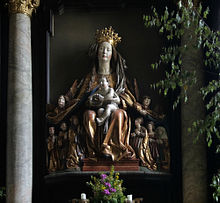Frauensteiner Schutzmantelmadonna
The Frauensteiner Schutzmantelmadonna from after 1510 is the work of Gregor Erhart . It is located on the high altar of the Frauenstein pilgrimage church in Molln .
Description and interpretation
The figure is a late Gothic protective cloak Madonna with child and two angels, carved from linden wood . The latter hold the cloak under which six other figures kneel. As is usual in such depictions, the Madonna and Child are shown oversized compared to their surroundings. She wears a crown made of filigree foliage , her head is tilted to the side and thus turned a little off the axis: In the child, the center of the composition, a vertical axis from the crown to the tip of the foot and a horizontal axis from angel to angel meet. The child is holding a wreath of roses. The clearly recognizable triangular composition already points to the Renaissance. The dimensions are: 195 cm high, 150 cm wide and 60 cm deep. The people under the coat kneel on a lawn bench. There are three men (left) and three women (right). The men hold their hands up in prayer and the women hold hers in front of their chests.
The wreath of roses held by the baby Jesus is probably related to the rosary prayer . Emperor Maximilian I (third from left) can be recognized under the coat and behind him one of his “ministers”, knight Florian Waldauf . On the right side presumably Maximilian's second wife Bianca Maria Sforza and behind her the wife Florian Waldaufs Barbara Mittenhofer . The two outer figures are well typed and perhaps only included in the composition because of the threesome.
history

According to a report by the knight Waldauf, he, the then Roman-German King Maximilian I, as well as "a lot of people" and prisoners on Epiphany 1489 in the Dutch Zuidersee were in distress. In the storm and fog, ice floes struck the ship and the desperate passengers called the Blessed Mother Mary. In fact, the fog is said to have lifted as a result and the saving shore could be reached. Waldauf donated a "treasure" and a Madonna in Hall near Innsbruck , Maximilian I. the protective coat Madonna in Frauenstein.
Maximilian's probable foundation was at first just one votive offering among many. A first reference dates back to 1894: The Klauser assistant priest Eberhard Bauer reported in his work "forget-me of Mrs. Stone": In addition, a very old wooden sculpture, unfortunately already strongly taken by the worm, 1.5 m wide, 1.95 m high , on the north wall next to the high altar, resting on two wooden consoles taken from the old broken side altars. The crowned mother, in a seated position, on her lap the baby Jesus, in delicate hands a wreath of roses. Bauer also reports that the Madonna was moved from the sacristy to the north wall next to the altar as part of a renovation of the church that began in 1886. In 1918 the statue was impregnated against worms and the numerous drill holes and damaged areas were cemented. The art historian Gustav Gugenbauer determined in 1925 that due to the lack of clergy under the protective cloak, it must be a secular foundation and identified the figure of Emperor Maximilian. On the basis of Gugenbauer's detailed recordings, the Munich art historian Karl Feuchtmayr attributed the Madonna to Gregor Erhart for the first time a little later. It was finally made known to the general public by the Schlierbach specialist teacher Josef Kurz. With the support of the diocesan art consultant Josef Fließner, he photographed the statue from 1935 to 1937 and compiled extensive background information. He gave 18 slide lectures in Upper Austria with the photographic material he had made. In 1937/38 the statue was extensively restored in the workshops of the Kunsthistorisches Museum Vienna . This included gasification of hydrogen cyanide as a measure against woodworm infestation , and the baroque color scheme (white for the veil, blue and white for the angel's wings) was removed and the earlier colors were exposed. Then she showed the museum in the exhibition Altdeutsche Kunst im Donauland . The last repair took place in 1967, since then the statue has taken its current place on the high altar.
literature
- Angela Mohr: The protective coat Madonna from Frauenstein. Ennsthaler Verlag, Steyr 1983, 2nd edition 1986. ISBN 3-85068-132-7
- Josef Kurz: Frauenstein and his protective coat Madonna. , Steyr Association Printing House, 1937, 40 pages.
Individual evidence
- Jump up ↑ The Madonna of Frauenstein , p. 33
- ↑ a b Willibald Girkinger, Wolfgang Heitzmann: The Steyr. Landscape and people on the river , p. 117
- ↑ Die Schutzmantelmadonna von Frauenstein , pp. 32–33.
- ↑ In: Zeitschrift für bildende Kunst 1926.
- ↑ Die Schutzmantelmadonna von Frauenstein , p. 71ff.
Web links
- Marburg picture archive: The protective coat Madonna before 1937 in the old baroque version (accessed on November 30, 2016)
